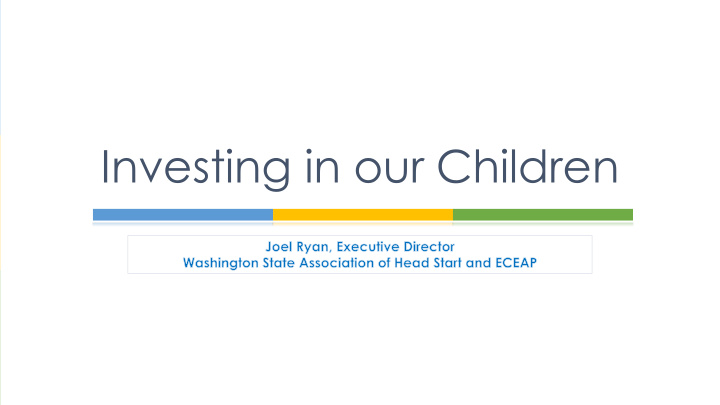



Investing in our Children
Washington’s Challenge
At-risk children are not graduating 2014 4-year WA High School Graduation Rates Foster Care 42% Low Income 66% Special Ed 56% Homeless 46% Hispanic 67% Black 68% White 81% 0% 10% 20% 30% 40% 50% 60% 70% 80% 90%
“60 to 70 percent of the socioeconomic status gap in achievement at age fourteen in the United States can be attributed to differences already present at school entry .”
K-12 can not close the gap
Upside Down Investing
Why Start Early?
Why Focus on At- Risk Kids?
Early Investment Pays Off
Benefits of Quality Pre-K – Short Term Special Education : 31% reduction in children in Special Ed (Special ed costs almost twice the annual cost of regular ed) Grade Retention : 35% less likely to be held back . In kindergarten alone 2000 kids were held back in 2013 at a cost of $11 million Remediation: The test score ‘fade out’ effect present in all early learning programs is largely attributed to intensive remedial efforts in K- 12 investing in ‘catching up’ the kids who start behind.
Benefits of Quality Pre-K – Long Term New Research – Head Start kids at 8 th grade higher in math, less absenteeism, less grade retention. Increases adult earnings by 7-25% and increases the chance that they are homeowners by age 27 by 3 times Michigan’s pre -k program, similar to WA, shows participants are 44% more likely to graduate from high school At-risk children not afforded the opportunity to participate are five times more likely to be arrested repeatedly by age 27 Young women who have experienced a quality early childhood program are one-third less likely to have out-of- wedlock births
New Research Increases adult earnings by 7-25% and increases the chance that they are homeowners by age 27 by 3 times Michigan’s pre -k program, similar to WA, shows participants are 44% more likely to graduate from high school At-risk children not afforded the opportunity to participate are five times more likely to be arrested repeatedly by age 27 Young women who have experienced a quality early childhood program are one-third less likely to have out-of- wedlock births
What is ECEAP? High Quality Pre-K Classrooms with well-trained teachers Individual school readiness plans for each child Serving 3-5 year olds from low-income families, homeless, disabled, or involved in child welfare
What is ECEAP? Parent Engagement Partnering with parents to support their child’s education Working on job, education, and financial goals Empowering parents to have a voice and develop advocacy skills
What is ECEAP? Health – Ready to Learn Connecting families to insurance, medical home, & necessary care Ensuring children are up- to-date on medical and dental Working with health- challenged children Nutrition, Activity, Obesity reduction and prevention
What about Washington? Good news: ECEAP (Early Childhood Education & Assistance Program) is one of the top quality programs nationwide. 2014 WSIPP Analysis found: ‘ Children who attended ECEAP had significantly higher math and reading scores in 3 rd , 4 th and 5 th grades compared to children who did not attend the program ”. “Return on Investment” estimated $4.20 for every dollar spent.
More good news! Bipartisan support for ECEAP and other early learning investments in Olympia (Early Start Act & Home Visiting) ECEAP has expanded by 3300 children since 2012 Legislature has committed to funding all eligible children who want ECEAP by 2020 (7400 new children)
The bad news Washington ranks 32 nd in the US in ACCESS to public pre-k. We serve almost 12,000 very low income children, but 12,000 are eligible but unserved. Thousands of kids just beyond our eligibility level have no affordable options, and are at high risk of school failure.
The Plan – Investing in the Future 2017 Legislative Session 7400 new spaces for ECEAP by 2020 (3700 in 2017- 18) Quality improvements in Child Care Preventing a wait list for Child Care Expanded access to home visiting and early intervention services for children Birth-3
“It is in the first 1,000 days of life that the stage is set for fulfilling individual potential. If we want to shape the future, to truly improve the world, we have 1,000 days to do it, mother by mother, child by child.”
Thank you Joel Ryan Executive Director Washington State Association of Head Start and ECEAP joel@wsaheadstarteceap.com 253.486.9077
Recommend
More recommend